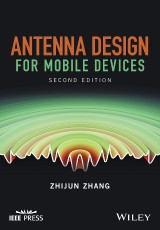Details

Antenna Design for Mobile Devices
IEEE Press 2. Aufl.
|
111,99 € |
|
| Verlag: | Wiley |
| Format: | |
| Veröffentl.: | 13.06.2017 |
| ISBN/EAN: | 9781119132356 |
| Sprache: | englisch |
| Anzahl Seiten: | 320 |
DRM-geschütztes eBook, Sie benötigen z.B. Adobe Digital Editions und eine Adobe ID zum Lesen.
Beschreibungen
<p><b>Expanded and updated, this practical guide is a one-stop design reference containing all an engineer needs when designing antennas</b></p> <ul> <li>Integrates state-of-the-art technologies with a special section for step-by-step antenna design</li> <li>Features up-to-date bio-safety and electromagnetic compatibility regulation compliance and latest standards</li> <li>Newly updated with MIMO antenna design, measurements and requirements</li> <li>Accessible to readers of many levels, from introductory to specialist</li> <li>Written by a practicing expert who has hired and trained numerous engineers</li> </ul>
About the Author x <p>Preface xi</p> <p>Acknowledgments xii</p> <p>Abbreviations xiii</p> <p><b>1 Introduction 1</b></p> <p>1.1 The Evolution of Mobile Antennas 2</p> <p>1.2 How to Quantitatively Evaluate an Antenna 10</p> <p>1.3 The Limits of Antenna Designs 12</p> <p>1.4 The Trade?]Offs in Antenna Designs 14</p> <p>1.5 Mobile Communication and Band Allocations 16</p> <p>1.6 Quickly Building a Simple Antenna—a Practical Example 18</p> <p>References 27</p> <p><b>2 Antenna Matching 28</b></p> <p>2.1 The Smith Chart 29</p> <p>2.2 Single?]Band Matching 33</p> <p>2.2.1 Matching with Lumped Elements 33</p> <p>2.2.2 Different Ways to Accomplish a Single?]Band Matching 36</p> <p>2.2.3 Matching with Both Transmission Line and Lumped Elements 39</p> <p>2.2.4 Bandwidth Consideration 42</p> <p>2.3 Dual?]Band Matching 50</p> <p>2.4 Reconfigurable Matching 55</p> <p>2.4.1 Reconfigurable Matching—Varactor?]Based 55</p> <p>2.4.2 Reconfigurable Matching—Switch?]Based 60</p> <p>References 63</p> <p><b>3 External Antenna 65</b></p> <p>3.1 Stubby Antennas 66</p> <p>3.1.1 Single?]Band Helix Stubby Antenna 67</p> <p>3.1.2 Multiband Helix Stubby Antenna 86</p> <p>3.1.3 Ultra?]Wideband Stubby Antenna 109</p> <p>3.2 Whip–Stubby (Retractable) Antenna 117</p> <p>3.2.1 Decoupled Whip–Stubby Antenna 119</p> <p>3.2.2 Semi?]Decoupled Whip–Stubby Antenna 121</p> <p>3.3 Meander Line Stubby Antenna 126</p> <p>3.4 Effect of Ground Plane 131</p> <p>References 136</p> <p><b>4 Internal Antenna 138</b></p> <p>4.1 Inverted?]F Antenna 141</p> <p>4.2 Planar IFA 146</p> <p>4.2.1 Single?]Band PIFA 146</p> <p>4.2.2 Multiband PIFA Antenna with Slits 149</p> <p>4.2.3 Multiband PIFA with Separate Branches 157</p> <p>4.2.4 Multiband PIFA with Parasitic Element 158</p> <p>4.2.5 Manufacturing PIFA Antenna 159</p> <p>4.3 Folded Monopole Antenna 163</p> <p>4.4 Loop Antenna 167</p> <p>4.5 Ceramic Antenna 172</p> <p>4.5.1 Monopole?]Type Ceramic Antenna 173</p> <p>4.5.2 IFA?]Type Ceramic Antenna 176</p> <p>4.5.3 Loop?]Type Ceramic Antenna 177</p> <p>4.6 Slot Antenna 179</p> <p>4.7 Design a Hepta?]Band Antenna with Multiple Radiators and Multiple Modes 185</p> <p>4.8 Design a Reconfigurable Hepta?]Band Antenna 191</p> <p>4.9 MIMO Antennas 200</p> <p>4.9.1 Explaining Capacity Boost Effect Through the Antenna Point of View 200</p> <p>4.9.2 Antenna Correlation and Antenna Isolation 207</p> <p>4.9.3 Improve Isolation Between Antennas 209</p> <p>4.10 Antennas in Recently Released Phones 211</p> <p>4.10.1 Entry?]Level Phone 211</p> <p>4.10.2 Flagship Phone 221</p> <p>References 226</p> <p><b>5 Antenna Measurement 229</b></p> <p>5.1 Passive Antenna Measurement 229</p> <p>5.1.1 Measurement on a Vector Network Analyzer 229</p> <p>5.1.2 Fixture 234</p> <p>5.1.3 Passive Chamber Measurement 246</p> <p>5.2 Active Antenna (Over the Air) Measurement 253</p> <p>5.2.1 EIRP, ERP, and TRP 253</p> <p>5.2.2 EIS and TIS 256</p> <p>5.2.3 Sensitivity Degradation Due to Interference 259</p> <p>5.3 Antenna Measurements in the Production Line 262</p> <p>5.4 Multiple Input and Multiple Output Antenna Test 271</p> <p>References 275</p> <p><b>6 Regulations Related to Antenna Engineers 276</b></p> <p>6.1 Specific Absorption Rate 276</p> <p>6.1.1 Definition and Measurement Method of SAR 277</p> <p>6.1.2 SAR Limits in the United States and Europe 283</p> <p>6.1.3 Controlling SAR 285</p> <p>6.1.4 Updates on SAR Requirement 294</p> <p>6.2 Hearing Aid Compatibility 296</p> <p>6.2.1 HAC Measurement 296</p> <p>6.2.2 HAC Specification in the United States 299</p> <p>6.2.3 Updates on HAC Requirement 303</p> <p>6.3 Electromagnetic Compatibility 304</p> <p>References 305</p> <p>Appendix: User Manual for ZJ_Antenna_Matching Software 307</p> <p>Index 314</p>
<p><b><i>Zhijun Zhang, Professor, Tsinghua University, Beijing, China. </i></b>He holds rich industry experience, with senior positions as an antenna development engineer at Amphenol T&M Antennas, Nokia, and Apple, giving him a perspective of design practices at a number of different players in the mobile segment. Prior to Tsinghua, his academic career included a postdoctoral fellowship and research professorship at the University of Utah, and a position as Assistant Researcher at the University of Hawaii, where he continues to serve as Adjunct Professor. Zhang earned a B.S. in Microwave Engineering and an M.S. in Applied Physics at the University of Electronic Science and Technology of China, Chengdu. He holds a PhD in Electronic Engineering from Tsinghua University.</p>
Diese Produkte könnten Sie auch interessieren:

Strategies to the Prediction, Mitigation and Management of Product Obsolescence

von: Bjoern Bartels, Ulrich Ermel, Peter Sandborn, Michael G. Pecht

116,99 €
















